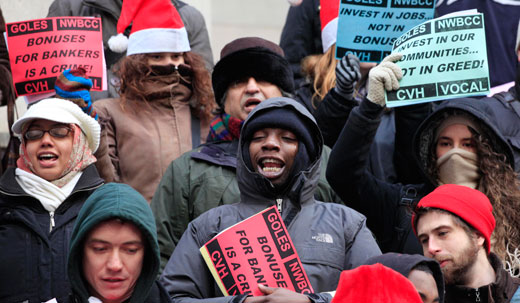
NEW YORK – Financial industry insiders are grousing about a big downturn in annual bonuses. They should be thanking about the rest of us – bombshell new research shows – for their continuing awesome good tidings. Let’s cry for them, all the way to the bank.
Wall Street’s power suits aren’t humming along, this December, with all the holiday jingles. Bankers, traders, and law firm partners quite frankly feel kind of foul. End-of-year Wall Street bonuses – note we said “bonuses,” not “pay,” – experts predict, are going to be down from 2010 levels by as much, on average, as 35 percent.
Total 2011 pay for the typical bond-trading managing director at a top Wall Street securities firm will likely be off, says analyst Michael Karp, nearly 40 percent.
But those typical managing directors should be able to survive the holidays quite nicely, thank you. Bonus cuts will leave average high-powered bond traders with $1.8 million for their daily labors in 2011. The average U.S. worker would have to labor 43 years – an adult lifetime – to take home that same $1.8 million.
In other words, by any real-world yardstick, Wall Street’s finest are doing just fine. And they owe their good fortune, the new research makes clear, to the generosity of Uncle Sam’s one and only central bank, the Federal Reserve.
During the financial meltdown, a new analysis of 29,000 pages of previously secret documents shows, central bankers at the Fed shoveled out an incredible $7.77 trillion in dirt-cheap loans to the nation’s financial institutions.
These are the same institutions that won’t lend you a dime to buy a house or expand a business or hire workers. These are the same institutions that illegally fore-closed on thousands of homeowners nationwide — even people who kept payments up in the Great Recession, not to mention the parents of one Oregon soldier returning from Iraq. Bank of America grabbed his boyhood home, the day before he came back to it.
This massive wave of low-cost loans, note the Bloomberg news analysts who broke the story, amounted to a bailout over ten times larger than the $700 billion funneled to banks via the Treasury Department’s controversial Troubled Asset Relief Program, or TARP.
Bloomberg reporters had to win a court case to access the stunning new bailout data. How stunning? The $7.77 trillion the Fed committed to the nation’s financial industry, observes Bloomberg, equaled “more than half the value of everything produced” in the entire United States during the key crisis year.
To put the bailout in more homespun terms: The Fed provided banks the equivalent of over $25,000 per American.
The nation’s six biggest banks – J.P. Morgan, Bank of America, Citibank, Wells Fargo, Goldman Sachs, and Morgan Stanley — grabbed $460 billion of the secret loans. Morgan Stanley took in $10 billion in publicly visible TARP dollars and $107 billion from the hidden Fed loan program.
All the TARP dollars came with modest strings on executive pay. To end run the strings, big banks rushed to pay back their TARP bailout and then loudly proclaimed themselves healthy and stable enough to resume business as usual.
Meanwhile, at that same moment, these “healthy” banks were taking advantage of the secret Fed loans to register billions in new profits – with no executive pay strings attached.
The Fed loans came with interest rates as low as 0.01 percent (read that again, then look at your bank’s credit card statement). The banks lent out these loan dollars at much higher rates and made, Bloomberg estimates, at least $13 billion on these transactions. That $13 billion, notes economist Dean Baker, essentially rates as a pure “gift” from taxpayers.
But the Fed’s total giving to America’s biggest banks has run much higher than that $13 billion. By backstopping big banks so energetically, former Sen. Ted Kaufman, D-Del., points out, the Fed served notice that the federal government would never let the big banks fail – and that notification continues to translate into favorable borrowing rates for the big banks.
The big banks, for their part, have pooh-poohed all the hubbub about the
enormous subsidies they’ve received. They’ve argued that no one should be bent out of joint, since the banks have paid their loans back.
The big banks, counters financial analyst Steve Randy Waldman, have definitely not paid back the lucrative freedom from downside risk that the Fed and Treasury Department so graciously provided them.
In financial markets, Waldman explains, “risk-bearing” has always been “the ultimate commodity.” The Fed and Treasury underwrote this risk-bearing – for big banks – at next to nothing. Middle class Americans, by contrast, have to pay for their own risk-bearing. They pay, for instance, their fire insurance bills year in and year out, without ever expecting that the Fed is going to foot the bill.
Massive federal bailout subsidies, adds analyst Les Leopold, have another spin-off benefit. They’ve “allowed banks to step up their lobbying efforts.” These lobbying efforts, in turn, have saved the banks countless billions more.
One example: Bank political pressure has forged a federal housing crisis policy that protects banks from the “downside” of the crash of the housing market.
But the generosity of top federal officials to America’s banks has gone still further. We learned last week, notes Reuters analyst Felix Salmon, that GOP President George W. Bush’s Treasury Secretary, Hank Paulson, was “giving inside information to his old Wall Street buddies” right as the financial crisis was unfolding, insider info that helped Goldman Sachs-connected hedge fund managers score millions in easy profits.
The bottom line of all this generosity? Total assets of America’s top six banks jumped from $6.8 trillion in September 2006 to $9.5 trillion in September 2011. The trading arms of big banks and other independent firms, the Washington Post reports, generated over $83 billion in profit over the last two and a half years, $6 billion more than they generated over the previous eight.
Returns this massive, in turn, translated last year into the biggest bank compensation haul in history. Wall Street salaries in New York averaged $361,330 in 2010, five times the city’s average private-sector pay.
And average Americans? Their economic status continues to slide. A new Rutgers University study out last week documents that just 7 percent of those Americans “who lost jobs after the financial crisis have returned to or exceeded their previous financial position.” Two million construction workers have lost jobs since the housing collapse began. The industry has hired back only 47,000.
That housing collapse keeps collapsing. Over a quarter of American mortgages, 28%, have now sunk “underwater,” up from 23 percent last year.
Some context for these numbers: The $107 billion in Fed loans that one bank alone, Morgan Stanley, pocketed in September 2008 would have been enough, notes Bloomberg, “to pay off one-tenth of the country’s delinquent mortgages.
So what ought to be done? For starters, former New York Attorney General and Governor Eliot Spitzer, Democrat, urged, Congress ought to require banks to use the profits they made investing their almost interest-free money from the Fed “to write down the value of mortgages of those who are underwater.”
And Nassim Nicholas Taleb – a New York University risk engineer, best-selling author, and a hedge fund investor – has a longer-term solution. He wants the feds to start regulating Wall Street pay. No one at a company that would require a taxpayer-financed bailout if it failed, says Taleb, should “get a bonus, ever.”
“Consider that we trust military and homeland security personnel with our lives, yet we don’t give them lavish bonuses,” he explains. “They get promotions and honor of a job well done if they succeed, and the severe disincentive of shame if they fail.”
For bankers, Taleb adds, the opposite holds. They get “a bonus if they make short-term profits and a bailout if they go bust.”
Reforms like these still seem, at our current political moment, sheer fantasy. New research from the Center for Responsive Politics helps us understand one reason. Nineteen current members of Congress last year held personal investments in Wall Street’s most notorious bank, Goldman Sachs. These investments averaged well over three-quarters of a million dollars each.
Nine of these congressional investors just happened to sit on the congressional committees that oversee the financial industry. Two of those who are not on one of these committees just happen to be the two most powerful leaders in the House, Speaker John Boehner, R-Ohio, and Majority Leader Eric Cantor, R-Va.












Comments